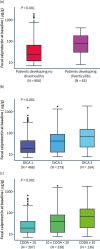Diverticular Inflammation and Complication Assessment classification, CODA score and fecal calprotectin in clinical assessment of patients with diverticular disease: A decision curve analysis
- PMID: 37550901
- PMCID: PMC10493361
- DOI: 10.1002/ueg2.12369
Diverticular Inflammation and Complication Assessment classification, CODA score and fecal calprotectin in clinical assessment of patients with diverticular disease: A decision curve analysis
Abstract
Background and aims: The Diverticular Inflammation and Complication Assessment (DICA) classification and the Combined Overview on Diverticular Assessment (CODA) were found to be effective in predicting the outcomes of Diverticular Disease (DD). We ascertain whether fecal calprotectin (FC) can further aid in improving risk stratification.
Methods: A three-year international, multicentre, prospective cohort study was conducted involving 43 Gastroenterology and Endoscopy centres. Survival methods for censored observations were used to estimate the risk of acute diverticulitis (AD) in newly diagnosed DD patients according to basal FC, DICA, and CODA. The net benefit of management strategies based on DICA, CODA and FC in addition to CODA was assessed with decision curve analysis, which incorporates the harms and benefits of using a prognostic model for clinical decisions.
Results: At the first diagnosis of diverticulosis/DD, 871 participants underwent FC measurement. FC was associated with the risk of AD at 3 years (HR per each base 10 logarithm increase: 3.29; 95% confidence interval, 2.13-5.10) and showed moderate discrimination (c-statistic: 0.685; 0.614-0.756). DICA and CODA were more accurate predictors of AD than FC. However, FC showed high discrimination capacity to predict AD at 3 months, which was not maintained at longer follow-up times. The decision curve analysis comparing the combination of FC and CODA with CODA alone did not clearly indicate a larger net benefit of one strategy over the other.
Conclusions: FC measurement could be used as a complementary tool to assess the immediate risk of AD. In all other cases, treatment strategies based on the CODA score alone should be recommended.
Keywords: CODA score; DICA score; acute diverticulitis; diverticular disease; diverticulosis; fecal calprotectin.
© 2023 The Authors. United European Gastroenterology Journal published by Wiley Periodicals LLC on behalf of United European Gastroenterology.
Conflict of interest statement
Silvio Danese, MD, PhD, served as speaker, consultant, and/or advisory board member for Abbvie, Allergan, Alfa Wassermann, Biogen, Boehringer Ingelheim, Celgene, Celltrion, Ferring, Gilead, Hospira, Johnson and Johnson, Merck, MSD, Mundipharma, Pfizer Inc., Sandoz, Takeda, Tigenix, UCB Pharma, Vifor: Giovanni Maconi, MD, served as speaker and/or advisory board fees for AlfaSigma, Arena, Janssen, Gilead, Roche; Gerardo Nardone, MD, PhD, received funding for target projects from Apharm and Sofar; Anna Pietrzak, MD, served as lecturer for AlfaSigma and Polpharma; Jaroslaw Regula, MD, PhD, served as lecturer for AlfaSigma, Takeda, Ipsen and Servier; Franco Scaldaferri, MD, PhD, served as lecturer for Sanofi; The remaining authors declare no competing interests.
Figures




References
-
- Köhler L, Sauerland S, Neugebauer E, Caprilli R, Fingerhut A, Haboubi NY, et al. Diagnosis and treatment of diverticular disease: results of a consensus development conference. The Scientific Committee of the European Association for Endoscopic Surgery. Surg Endosc. 1999;13(4):430–436. 10.1007/s004649901007 - DOI - PubMed

